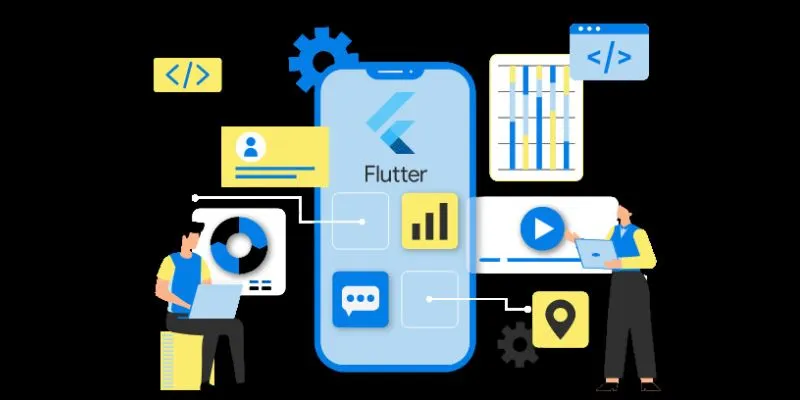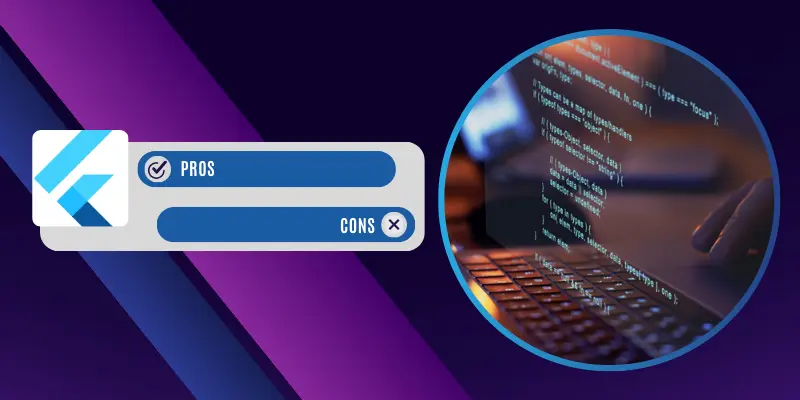The mobile app development industry has become highly competitive with the revolutionary arrival of Flutter and React Native frameworks. These two cross-platform app development frameworks have been trendsetters since day one. People have keenly observed the enormous changes in the development of mobile apps in recent times. Industries, such as healthcare, automobile, retail, agriculture, entertainment, gaming, and many such industries have transformed the way businesses function. In addition, the Flutter Vs React Native discussion has divided the tech companies, solidifying the competition further. Nowadays, businesses prefer to build the most communicative and interactive mobile apps. Both cross-platform mobile app development frameworks have their quirks and functionalities making them special for the faster development of futuristic mobile apps.
Now, the question arises, which cross-platform app development framework is best for your business idea? Before finding an answer to this question and reaching a conclusion, let’s understand these two multi-platform app development frameworks: Flutter and React Native, in detail-
What is Flutter?
Flutter framework was created by Google using Dart programming language in 2017. This open-source UI framework exhibits high compatibility with different platforms, such as Android, iOS, Windows, Web, and MacOS, during the mobile app development process. With the presence of a rich library, functions, and tools, mobile app developers around the world are capable of building powerful and high-performing mobile applications in much less time and cost.
Nowadays, the Flutter app development solution is one of the most preferred cross-platform mobile app development techniques among developers. With the rise of usage of mobile applications, the popularity and demand for Flutter mobile apps are going up at a much faster rate across many industry verticals. As of 2023, Flutter 3.10 has come to the market with all the advanced updates and additions. With that, A flutter app development company has become high in demand for mobile application development.
What is React Native?
React Native is another extremely popular cross-platform app development framework created by Meta in 2015. Unlike native app development frameworks, React Native exhibits better compatibility across all platforms, such as Android, iOS, MacOS, Windows, and Web. This multi-platform app development framework uses JavaScript and a special markup language, JSX. React Native also uses native mobile user interface elements during the cross-platform app development process.
In other words, React Native app development solution involves the use of functions of React framework while taking advantage of native platform capabilities. Therefore, React native app development framework showcases highly interactive and responsive app development characteristics resulting in a great user experience. As of 2023, the latest version of React Native 0.71 is being used by global developers. With that, the value of a React Native app development company has increased over the past few years.
Market Analysis
Indeed, the market value of cross-platform app development frameworks- Flutter and React Native is high. Businesses belonging to different industry verticals prefer to choose a cross-platform app development company to build their mobile apps and stay ahead of their competitors.
Let’s look at market insights-
- In 2019, React Native was the most popular cross-platform framework for mobile app development. By the end of 2022, Flutter became one of the most preferred cross-platform mobile app development frameworks leaving React Native behind.
- Study shows that Flutter, React Native, and Cordova were the most popular multi-platform mobile app development frameworks in 2019 with 30%, 42%, and 29% market shares respectively.
- In 2022, .NET, NumPy, and Pandas were the top three most used libraries and frameworks among global developers with a market share of about 34.55%, 28.65%, and 25.08% respectively. Data analysis and machine learning technologies like Pandas and TensorFlow have contributed to the growth of the usage of such frameworks.
- According to a study, among the most wanted libraries and frameworks by global developers, Flutter was the choice of 13.52% while React Native was the choice of 13.05%.
- In 2022, the top five most used libraries and frameworks were .Net, NumPy, Pandas, Spring, and TensorFlow.
- The number of mobile app developers has been increasing by many folds in the last few years. In 2020, there were over 24.5 million software developers worldwide.
Now, you are aware of the market demand and popularity of cross-platform app development frameworks. If you wish to build your business application using cross-platform app development services, you must know about the top players in your industry.
Here, let’s look at the top Flutter and React Native-based leading business mobile apps-
Popular Flutter and React Native Apps

Flutter-based applications include BMW, Abbey Road Studios, Alibaba Group, Beike, Google Pay, Byte Dance, Crowd Source, Dream11, eBay, Nubank, Patch Me: Eye Patch Tracking, Push, Quinto Andar, Reflectly, Rive, and many more apps related to many industry verticals.
React Native-based applications include Facebook, Facebook Ad Manager, Oculus, Messenger Desktop, Microsoft Office apps, Shopify apps, Wix, Discord, Mercari, Puma, Mattermost, Tableau, NFL, Bloomberg, Pinterest, Coinbase, and many more apps belonging to various industry verticals.
How Does the Cross-platform App Development Framework Function?
Cross-platform frameworks allow the flexibility of using a single codebase compatible with all platforms. Mobile app developers write the shareable for one platform and reuse it to develop a multi-platform application. The single code base approach helps developers fasten the app development process without any compatibility issues on different platforms, such as Android, iOS, MacOS, Windows, and the Web. The speed of cross-platform mobile app development significantly depends on the complexity and size of the project. However, at the end of the mobile app development process, the functioning of cross-platform apps works similarly on all platforms.
Flutter vs React Native
Performance
Since Flutter app development requires Dart programming language, compilation of a single code is much faster and easier resulting in showcasing high performance. React Native uses both Native and platform-compatible components to build robust cross-platform applications. On the other hand, Flutter uses Dart language to develop the app code. React Native and Flutter architecture are a bit different. Regarding Flutter vs React Native, React Native uses flux architecture which requires bridging between JavaScript and Native codes to interact and function well. Whereas, Flutter architecture does not require any programming bridging because it uses a 2D graphics library, Skia.
To conclude, when it comes to Flutter vs React Native, React Native apps perform better than Flutter apps. React Native apps are faster, more responsive, and perform just like native apps. Though such differences can only be seen in extreme cases. And with other advantages Flutter offers, developers and most mobile app development companies still choose Flutter over React Native.
UI
Concerning Flutter vs React Native, Flutter has its library which helps developers incorporate the animations, graphics, and other UI components easier in the app code, while the React Native framework depends on third-party libraries. Flutter also offers the reuse of plugins that makes the cross-platform app development process easy. React Native app development framework allows the usage of native platform capabilities. Thus they are essential to developing eye-catching and user-friendly graphics that feel like native apps.
In addition, Flutter has an extensive library consisting of code snippets and app templates to develop a robust app. Developers can use the Flutter UI toolkit and SDK to add attention-grabbing graphics. These graphics work the same for every platform whether it is Android, iOS, Windows, MacOS, or Web. All the widgets and tools in the library are customizable and reusable. Therefore, it helps developers to experiment during the Flutter app development process according to their needs and requirements.
Documentation
Cross-platform mobile app developers prefer the Flutter framework because it is descriptive and highly organized. Though developers are required to visit the website to see the changes, that is hardly a concern for many developers. Due to its detailed and standardized library, Flutter showcases a low volume of problems in the software. The Flutter app documentation includes details regarding libraries, services, animation, semantics, Cupertino, scheduler, foundation, widgets, material, painting, Dart, physics, rendering, code encoders & decoders, web, web driver, and other variety of information.
React Native documentation is considered more well-organized and user-friendly in the matter of Flutter vs React Native. It usually consists of popular topics and guides. The React Native documentation covers the details of core & native components, react fundamentals, handling text input, environment setup, troubleshooting, platform-specific code, workflow, design, interaction, JavaScript Runtime, performance, and other necessary information.
In short, Flutter documentation is well-organized and structured while React Native documentation is poorly managed as it depends on third-party libraries.
Community
The Flutter community is one of the most active and supportive programming language communities in the tech world. Regardless of experience level, Flutter offers full support and inclusiveness at any time. As one of the most reliable programming language communities in the world of mobile app development, developers can expect all the necessary information, updates, news, and resources from other developers. In addition, Flutter developers offer multimedia resources to help developers enhance their skills, such as Youtube videos, channels, etc.
By exhibiting a faster and easier development and deployment time, React Native has attracted thousands of developers worldwide. React Native community is one of the fastest-growing cross-platform app development framework communities worldwide. React Native framework uses JavaScript, a widely used programming language. The development and deployment process with React Native is easier to build native-like apps faster. Such characteristics make the React Native community grow exponentially.
Development
As the Flutter app development framework requires the incorporation of different code files for Android and iOS operating systems, development speed reduces. Therefore, when it comes to Flutter vs React Native, Flutter has a little lower development speed than React Native Framework. Further, a complicated UI function requires more time in most cross-platform app development processes. Since Flutter has its libraries and tools, the development time can be decreased.
Regarding React Native app development speed, it’s faster as access to ready-to-use third-party plugins reduces the development time significantly. The “Hot Reload” feature in both Flutter and React Native makes the application development process faster and smoother. Unlike Flutter, React Native offers UI rendering and APIs, which shows this framework's dependency on third-party libraries.
Pros and Cons of Flutter
Indeed, the tech world has plenty of cross-platform app development frameworks to choose from and develop robust and the most interactive mobile apps. The Flutter app development framework showcases some of the most exuberant qualities in mobile applications along with certain limitations as it is still a novel framework.
Let’s look at the pros and cons of using the Flutter framework for the development of exclusive mobile apps-
Pros of Flutter Framework
Free and open-source Library of customizable widgets and tools Easy access to native features Hot reload approach No framework bridge Use of a single programming language Easy compilation Single code base approach Straightforward and detailed documentation High performance and user-friendly Supportive community and cost-effectiveCons of Flutter Framework
A little slower development than React Native Limited support from third parties Quite a young technologyPros and Cons of React Native
React Native app development framework is one of the most popular cross-platform frameworks in the tech world for futuristic mobile app development. Like Flutter, React Native has its own advantages and limitations you must be aware of-
Pros of React Native Framework
Faster mobile app development time Swift app deployment speed budget-friendly and highly efficient Native-like app look and feel Live reload approach Code reusability UI focused Third-party plugins Large community support Faster development and deployment time compared to FlutterCons of React Native Framework
Not all features are usefulI efficient for complex interfacesIssues with updates, bigger apps Debugging and troubleshooting issuesFuture Scope of Flutter and React Native
React Native and Flutter app development frameworks work as bridges between traditional native apps and futuristic mobile app development approaches. These cross-platform app development frameworks function faster and exhibit native-like app visualization and feel. Therefore, developers around the world prefer these two multi-platform frameworks to develop futuristic mobile applications. While working with React Native framework, developers can design UIs, build their controls, and easily integrate across all platforms. In addition, JavaScript is already a popular programming language to build app codes and use libraries. Therefore, with regards to Flutter vs React Native, developers can easily build mobile applications using either one.
On the other hand, Flutter is a relatively new framework but uses a single programming language, Dart. In addition, Flutter has its own graphics library, Skia, and SDK, which provides customized widgets and tools to use. Due to this, compilation becomes faster and exhibits negligible bug issues. Therefore, Flutter applications are becoming more popular as the day goes by. Thus, it can be said that the future of cross-platform app development with Flutter and React Native is bright and promising. As the usage and demand for unique mobile applications in various industries will increase, new approaches and techniques would also emerge.
Conclusion
Indeed, Flutter and React Native app development frameworks are different and unique approaches to building mobile applications. Yet, they have a lot of similarities as well. Both frameworks are open-source that any developers, regardless of their experience, can use and customize according to requirements. Both framework communities are active and highly supportive. Due to recent updates, it can be concluded that Flutter is resistant to system updates and works smoothly. Even if it is relatively a new technology, it still is taking the world of technology by storm. Developers for various reasons and requirements work on both React Native and Flutter app development technologies. If you wish to build cross-platform mobile applications, then you can choose either one as per your business model and vision. You must also conduct market research first and choose a competent cross-platform app development company to turn your idea into reality.
FAQs
Q1. Does Flutter exhibit better performance than React Native?
Flutter uses one programming language and its graphic library. The animation standard is set for Flutter functions at 60 FPS. therefore, making it the high-performing app development framework. On the other hand, React Native requires JavaScript bridges and various modules which slows down its speed.
Q2. Which one should I choose for custom mobile app development? Flutter or React Native?
Flutter requires a comparatively higher SDK, a version 16, and can be compiled into Android 4.1. Whereas React Native works well with lower versions of SDKs. in addition, React Native apps are comparatively lightweight and demand less code. Custom mobile app development also depends on several considerable factors.
Q3. Can Flutter and React Native be used together?
Flutter and React Native are both cross-platform app development works and can be used together. However, it is not a common approach. Both frameworks use different architectural approaches to build the app code. Working together with both frameworks on one application will only complicate things and demand extra effort. Along with complexity, compatibility issues will also arise. That’s why developers must use only one cross-platform app development framework at a time.
Q4. Can Flutter be a beneficial solution for business and startups?
From a business perspective, a mobile application must work efficiently across all platforms, be user-friendly with a simple navigation process, and be in the budget range. Also, the application must show little to no bug issues for the rapid app development process. The Flutter app development solution exhibits all these qualities suitable for a business and startup mobile app.












Share this blog